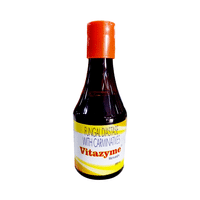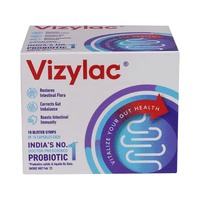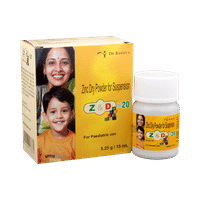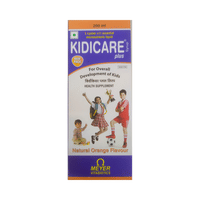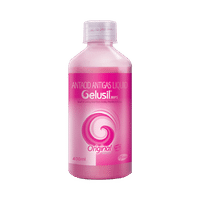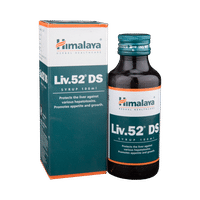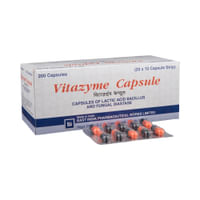Rs.87.40for 1 strip(s) (15 tablets each)
food interaction for Sobinix Tablet
alcohol interaction for Sobinix Tablet
pregnancy interaction for Sobinix Tablet
lactation interaction for Sobinix Tablet
food
alcohol
pregnancy
lactation
Sobinix DS 1000mg Tablet may be taken with or without food, but it is better to take it at a fixed time.
None
None
CAUTION
It is unsafe to consume alcohol with Sobinix DS 1000mg Tablet.
UNSAFE
Sobinix DS 1000mg Tablet may be unsafe to use during pregnancy. Although there are limited studies in humans, animal studies have shown harmful effects on the developing baby. Your doctor will weigh the benefits and any potential risks before prescribing it to you. Please consult your doctor.
CONSULT YOUR DOCTOR
Information regarding the use of Sobinix DS 1000mg Tablet during breastfeeding is not available. Please consult your doctor.
CONSULT YOUR DOCTOR
SALT INFORMATION FOR Sobinix 1000mg Tablet
Sodium Bicarbonate(1000mg)
Sobinix tablet uses
{med_name} is used as Metabolic acidosis. It is used as an alkalinizing agent in the treatment of metabolic acidosis, severe diarrhea, acidity, and poisoning.
How sobinix tablet works
Sobinix DS 1000mg Tablet works primarily by providing a source of bicarbonate ions to the body. Sobinix DS 1000mg Tablet neutralizes the acidity in the stomach, providing relief from the discomfort of acid reflux or heartburn. It can help temporarily increase the pH of the blood, making it less acidic. This property can be useful in certain medical situations, such as metabolic acidosis, where the body becomes too acidic due to conditions like kidney dysfunction or severe dehydration. Sobinix DS 1000mg Tablet may also help in cases where the urine needs to be less acidic, such as when trying to promote the excretion of certain drugs or when managing certain urinary tract conditions.
Common side effects of sobinix tablet
Increased sodium level in blood, Brain swelling, Alkalosis, Decreased potassium level in blood
SUBSTITUTES FOR Sobinix Tablet
111 Substitutes
111 Substitutes
Sorted By
 Rs. 92.81pay 53% more per Tablet
Rs. 92.81pay 53% more per Tablet Rs. 70.31pay 14% more per Tablet
Rs. 70.31pay 14% more per Tablet Rs. 65.63pay 13% more per Tablet
Rs. 65.63pay 13% more per Tablet Rs. 112.13pay 24% more per Tablet
Rs. 112.13pay 24% more per Tablet Rs. 78.75pay 30% more per Tablet
Rs. 78.75pay 30% more per Tablet
Expert advice FOR Sobinix Tablet
- Take Sodium Bicarbonate at least 1 to 2 hours before or after other medications, as it may affect their absorption.
- Avoid taking it with large meals regularly, as excessive use can lead to rebound acidity.
- Avoid Sodium Bicarbonate, if you show signs of appendicitis or inflammed bowel (such as lower abdominal pain, cramping, bloating, nausea, vomiting). Please consult your doctor.
- Do not use it as a long-term solution for heartburn or acidity without medical supervision.
- Monitor sodium intake if you have high blood pressure, kidney issues, or are on a salt-restricted diet.
- Dissolve the Sodium Bicarbonate completely in water before consuming to reduce the risk of stomach discomfort.
Frequently asked questions FOR Sobinix 1000mg Tablet
Sodium Bicarbonate
Q. What is the difference between medical-grade sodium bicarbonate (present in Sobinix DS 1000mg Tablet) and regular baking soda?
Medical-grade baking soda (present in Sobinix DS 1000mg Tablet) includes medical-grade purity and quality control, precise dosing in medical formulations, professional oversight of treatment, and specific medical packaging. However, regular baking soda is mostly used for cooking and baking. It helps the baked product rise and be fluffy. Always use the prescribed form rather than kitchen baking soda.
Q. When should I take Sobinix DS 1000mg Tablet?
You can take Sobinix DS 1000mg Tablet for heartburn when symptoms occur, while for chronic conditions, you should take it as prescribed by your doctor. It is usually taken between meals, and it is better not to take it within 2 hours of other medications. Follow specific instructions for your condition.
Q. What serious side effects should I watch for?
You should seek medical attention if you experience serious side effects of Sobinix DS 1000mg Tablet such as severe stomach pain, swelling of feet or ankles, unusual weakness, slow breathing, and mood changes. These could indicate serious complications.
















